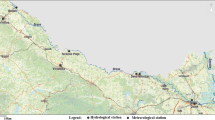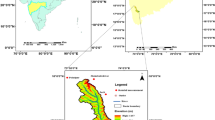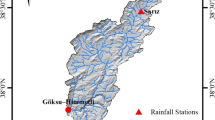Abstract
Reliable and precise prediction of the rivers flow is a major concern in hydrologic and water resources analysis. In this study, multi-linear regression (MLR) as a statistical method, artificial neural network (ANN) and adaptive neuro-fuzzy inference system (ANFIS) as non-linear ones and K-nearest neighbors (KNN) as a non-parametric regression method are applied to predict the monthly flow in the St. Clair River between the US and Canada. In the developed methods, six scenarios for input combinations are defined in order to study the effect of different input data on the outcomes. Performances of the models are evaluated using statistical indices as the performance criteria. Results obtained show that adding lag times of flow, temperature and precipitation to the inputs improve the accuracy of the predictions significantly. For a further investigation, the aforementioned models are coupled with wavelet transform. Using the wavelet transform improves the values of Nash-Sutcliff coefficient to 0.907, 0.930, 0.923, and 0.847 from 0.340, 0.404, 0.376 and 0.419 respectively, by coupling it with MLR, ANN, ANFIS, and KNN models.








Similar content being viewed by others
References
Adamowski J, Chan HF, Prasher SO, Sharda VN (2012) Comparison of multivariate adaptive regression splines with coupled wavelet transform artificial neural networks for runoff forecasting in Himalayan micro-watersheds with limited data. J Hydroinf 14(3):731–744
Ahani A, Shourian M, Rad PR (2018) Performance assessment of the linear, nonlinear and nonparametric data driven models in river flow forecasting. Water Resour Manag 32(2):383–399
Alizadeh MJ, Kavianpour MR, Kisi O, Nourani V (2017) A new approach for simulating and forecasting the rainfall-runoff process within the next two months. J Hydrol 548:588–597
Aqil M, Kita I, Yano A, Nishiyama S (2007) A comparative study of artificial neural networks and neuro-fuzzy in continuous modeling of the daily and hourly behaviour of runoff. J Hydrol 337(1):22–34
Babovic V (2005) Data mining in hydrology. Hydrol Process 19(7):1511–1515
Cioffi F, Conticello F, Hall T, Lall U, Orton P (2014) A statistical forecast model for tropical cyclone rainfall and flood events for the Hudson River. EGU General Assembly Conference Abstracts
Daubechies I (1990) The wavelet transform, time-frequency localization and signal analysis. IEEE Trans Inf Theory 36(5):961–1005
De Vos N, Rientjes T (2008) Multiobjective training of artificial neural networks for rainfall-runoff modeling. Water Resour Res 44(8):1–15
Ebrahimi H, Rajaee T (2017) Simulation of groundwater level variations using wavelet combined with neural network, linear regression and support vector machine. Glob Planet Chang 148:181–191
El-Shafie A, Taha MR, Noureldin A (2007) A neuro-fuzzy model for inflow forecasting of the Nile river at Aswan high dam. Water Resour Manag 21(3):533–556
Fahimi F, Yaseen ZM, El-shafie A (2017) Application of soft computing based hybrid models in hydrological variables modeling: a comprehensive review. Theor Appl Climatol 128(3–4):875–903
Fix E, Hodges JL Jr (1951) Discriminatory analysis-nonparametric discrimination: consistency properties. DTIC Document
Ghose DK, Panda SS, Swain PC (2010) Prediction of water table depth in western region, Orissa using BPNN and RBFN neural networks. J Hydrol 394(3):296–304
He Z, Wen X, Liu H, Du J (2014) A comparative study of artificial neural network, adaptive neuro fuzzy inference system and support vector machine for forecasting river flow in the semiarid mountain region. J Hydrol 509:379–386
Hidayat H, Hoitink A, Sassi M, Torfs P (2014) Prediction of discharge in a Tidal River using artificial neural networks. J Hydrol Eng 19(8):04014006
Humphrey GB, Gibbs MS, Dandy GC, Maier HR (2016) A hybrid approach to monthly streamflow forecasting: integrating hydrological model outputs into a Bayesian artificial neural network. J Hydrol 540:623–640
Hunter TS, Clites AH, Campbell KB, Gronewold AD (2015) Development and application of a north American Great Lakes hydrometeorological database - part I: precipitation, evaporation, runoff, and air temperature. J Great Lakes Res 41(1):65–77
Huo Z, Feng S, Kang S, Huang G, Wang F, Guo P (2012) Integrated neural networks for monthly river flow estimation in arid inland basin of Northwest China. J Hydrol 420:159–170
Jang J-S (1993) ANFIS: adaptive-network-based fuzzy inference system. IEEE Trans Syst Man Cybern 23(3):665–685
Jang J-S, Sun C-T (1995) Neuro-fuzzy modeling and control. Proc IEEE 83(3):378–406
Jang JSR, Sun CT, Mizutani E, Ho Y (1998) Neuro-fuzzy and soft computing--a computational approach to learning and machine intelligence. Proc IEEE 86(3):600–603
Karran DJ, Morin E, Adamowski J (2014) Multi-step streamflow forecasting using data-driven non-linear methods in contrasting climate regimes. J Hydroinf 16(3):671–689
Kasiviswanathan K, He J, Sudheer K, Tay J-H (2016) Potential application of wavelet neural network ensemble to forecast streamflow for flood management. J Hydrol 536:161–173
Krstanovic P, Singh V (1991) A univariate model for long-term streamflow forecasting. Stoch Hydrol Hydraul 5(3):173–188
Kuo Y-M, Liu C-W, Lin K-H (2004) Evaluation of the ability of an artificial neural network model to assess the variation of groundwater quality in an area of Blackfoot disease in Taiwan. Water Res 38(1):148–158
Latt ZZ, Wittenberg H (2014) Improving flood forecasting in a developing country: a comparative study of stepwise multiple linear regression and artificial neural network. Water Resour Manag 28(8):2109–2128
Liu H, Zhang S (2012) Noisy data elimination using mutual k-nearest neighbor for classification mining. J Syst Softw 85(5):1067–1074
Liu Z, Zhou P, Chen G, Guo L (2014) Evaluating a coupled discrete wavelet transform and support vector regression for daily and monthly streamflow forecasting. J Hydrol 519:2822–2831
Maier HR, Dandy GC (2000) Neural networks for the prediction and forecasting of water resources variables: a review of modelling issues and applications. Environ Model Softw 15(1):101–124
Makwana JJ, Tiwari MK (2014) Intermittent streamflow forecasting and extreme event modelling using wavelet based artificial neural networks. Water Resour Manag 28(13):4857–4873
McRoberts RE (2012) Estimating forest attribute parameters for small areas using nearest neighbors techniques. For Ecol Manag 272:3–12
Mehr AD, Kahya E, Yerdelen C (2014) Linear genetic programming application for successive-station monthly streamflow prediction. Comput Geosci 70:63–72
Minns A, Hall M (1996) Artificial neural networks as rainfall-runoff models. Hydrol Sci J 41(3):399–417
Modini GC (2000) Long-lead precipitation outlook augmentation of multi-variate linear regression streamflow forecasts. Proceedings of the 68th annual Western snow conference
Nourani V, Komasi M, Mano A (2009) A multivariate ANN-wavelet approach for rainfall-runoff modeling. Water Resour Manag 23(14):2877–2894
Nourani V, Baghanam AH, Adamowski J, Kisi O (2014) Applications of hybrid wavelet–artificial intelligence models in hydrology: a review. J Hydrol 514:358–377
Orimi MG, Amiri R, Yazdi S, Besheli RA (2014) River discharge prediction using artificial neural network and support vector machine. Adv Environ Biol 8(4)
Ozbayoglu G, Ozbayoglu ME (2006) A new approach for the prediction of ash fusion temperatures: a case study using Turkish lignites. Fuel 85(4):545–552
Partal T (2016) Wavelet regression and wavelet neural network models for forecasting monthly streamflow. Jour Wat & Clim Chang 8(1):48–61
Prasad R, Deo RC, Li Y, Maraseni T (2017) Input selection and performance optimization of ANN-based streamflow forecasts in the drought-prone Murray Darling basin region using IIS and MODWT algorithm. Atmos Res 197:42–63
Rajaee T (2011) Wavelet and ANN combination model for prediction of daily suspended sediment load in rivers. Sci Total Environ 409(15):2917–2928
Rezaeianzadeh M, Tabari H, Yazdi AA, Isik S, Kalin L (2014) Flood flow forecasting using ANN, ANFIS and regression models. Neural Comput & Applic 25(1):25–37
Sahay RR, Srivastava A (2014) Predicting monsoon floods in rivers embedding wavelet transform, genetic algorithm and neural network. Water Resour Manag 28(2):301–317
Senthil Kumar A, Sudheer K, Jain S, Agarwal P (2005) Rainfall-runoff modelling using artificial neural networks: comparison of network types. Hydrol Process 19(6):1277–1291
Shamseldin AY (2004) Hybrid neural network modelling solutions. In: Neural networks for hydrological modeling. AA Balkema Publishers, Leiden, pp 61–79
Shoaib M, Shamseldin AY, Melville BW, Khan MM (2016) Hybrid wavelet neural network approach. Artificial neural network modelling. Springer, pp 127–143
Shu C, Ouarda T (2008) Regional flood frequency analysis at ungauged sites using the adaptive neuro-fuzzy inference system. J Hydrol 349(1):31–43
Singh KP, Basant A, Malik A, Jain G (2009) Artificial neural network modeling of the river water quality- a case study. Ecol Model 220(6):888–895
Sivapragasam C, Vanitha S, Muttil N, Suganya K, Suji S, Selvi MT, Selvi R, Sudha SJ (2014) Monthly flow forecast for Mississippi River basin using artificial neural networks. Neural Comput & Applic 24(7–8):1785–1793
Sudheer K, Gosain A, Ramasastri K (2002) A data-driven algorithm for constructing artificial neural network rainfall-runoff models. Hydrol Process 16(6):1325–1330
Sudheer C, Maheswaran R, Panigrahi BK, Mathur S (2014) A hybrid SVM-PSO model for forecasting monthly streamflow. Neural Comput & Applic 24(6):1381–1389
Tabari H, Sabziparvar A-A, Ahmadi M (2011) Comparison of artificial neural network and multivariate linear regression methods for estimation of daily soil temperature in an arid region. Meteorog Atmos Phys 110(3–4):135–142
Talei A, Chua LHC, Wong TS (2010) Evaluation of rainfall and discharge inputs used by adaptive network-based fuzzy inference systems (ANFIS) in rainfall-runoff modeling. J Hydrol 391(3):248–262
Taormina R, Chau K-W, Sethi R (2012) Artificial neural network simulation of hourly groundwater levels in a coastal aquifer system of the Venice lagoon. Eng Appl Artif Intell 25(8):1670–1676
Wang Z, Palade V, Xu Y (2006) Neuro-fuzzy ensemble approach for microarray cancer gene expression data analysis. In: Evolving fuzzy systems, 2006 international symposium on. IEEE
Wu C, Chau K (2011) Rainfall-runoff modeling using artificial neural network coupled with singular spectrum analysis. J Hydrol 399(3):394–409
Yan H, Zou Z, Wang H (2010) Adaptive neuro fuzzy inference system for classification of water quality status. J Environ Sci 22(12):1891–1896
Yang T, Asanjan AA, Welles E, Gao X, Sorooshian S, Liu X (2017) Developing reservoir monthly inflow forecasts using artificial intelligence and climate phenomenon information. Water Resour Res 53(4):2786–2812
Yaseen ZM, Jaafar O, Deo RC, Kisi O, Adamowski J, Quilty J, El-Shafie A (2016) Stream-flow forecasting using extreme learning machines: a case study in a semi-arid region in Iraq. J Hydrol 542:603–614
Yaseen ZM, Fu M, Wang C, Mohtar WHMW, Deo RC, El-Shafie A (2018) Application of the hybrid artificial neural network coupled with rolling mechanism and grey model algorithms for streamflow forecasting over multiple time horizons. Water Resour Manag 32(5):1883–1899
Author information
Authors and Affiliations
Corresponding author
Ethics declarations
Conflict of Interest
Authors declare that they have no conflict of interests.
Additional information
Publisher’s Note
Springer Nature remains neutral with regard to jurisdictional claims in published maps and institutional affiliations.
Rights and permissions
About this article
Cite this article
Khazaee Poul, A., Shourian, M. & Ebrahimi, H. A Comparative Study of MLR, KNN, ANN and ANFIS Models with Wavelet Transform in Monthly Stream Flow Prediction. Water Resour Manage 33, 2907–2923 (2019). https://doi.org/10.1007/s11269-019-02273-0
Received:
Accepted:
Published:
Issue Date:
DOI: https://doi.org/10.1007/s11269-019-02273-0




